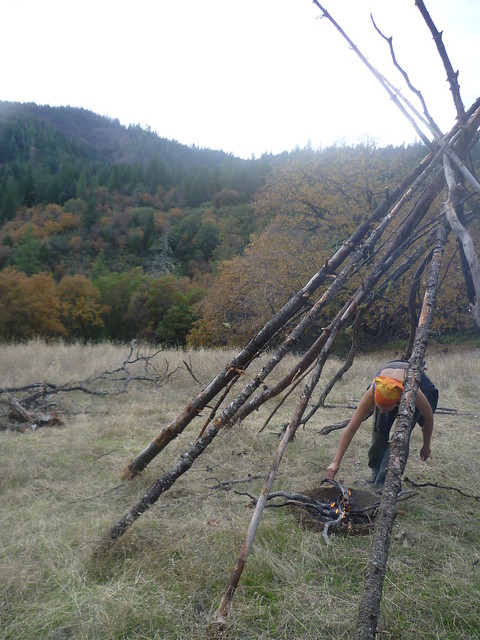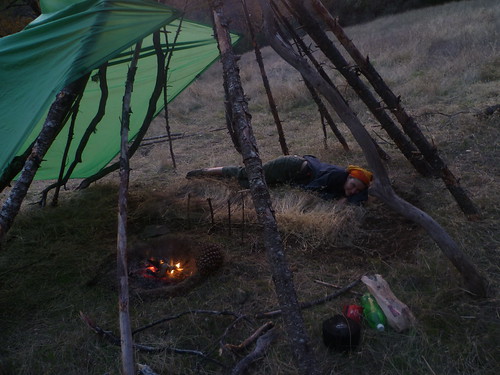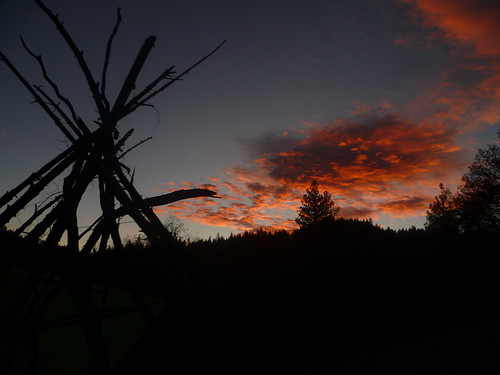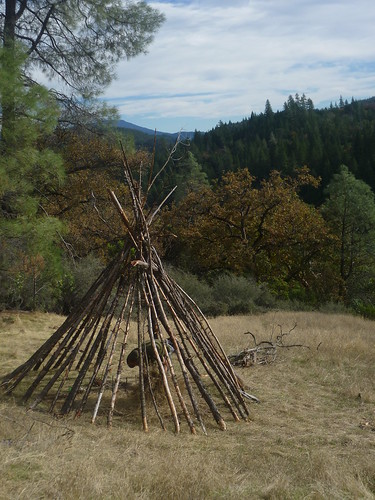Building a Wickiup
2010-11-22
Jess and I got the great idea of building a Wickiup.
Well, In particular Jess got me a Kukri - and I really wanted to play with it (I.E. hack at something). What better test it than to build a pole Wickiup! The plan was simple. We'd go up to Mendocino National Forest, possibly try several areas until we found a good stop to build one, and then start building. We've been wanting a consistent area to go to to try and learn, so we have the option to spend more time doing bush-crafty things and less time "backpacking".
The wickiup we planned to build is a small temporary structure, we're not removing wood from the forest (just moving it around), and we figured we'd only use deadwood to do it. A quick scan of the regulations we could find and based on reading other's experienced, it seems fine to just do it - so we did.
We rented a compact car as usual and did a few drifts on our way up (aveo has nice clearance, never hit the bumper). We had an idea for a spot, so we drove there and slept by the road that night (it's fall, so it was dark by the time we left home, much less got to our spot). We set up a tarp to ward off the dew and went to sleep.
It was a cold and damp night. We got the wind direction wrong and it came from where the camera is for the photo. You may note that in that direction the tarp will catch the dew and carefully direct it onto us. We had also figured on sleeping in unestablished camps, so we had no sleepingpads. As a result we woke up very early, cold, damp, stiff, and a bit cranky.
After some quick oatmeal cooked on the wood-stove we got moving up the river valley we'd selected. We picked a side of the river based on the pine forests on that side - thinking it would be easier to build there. After walking down it a bit we realized this was a poor choice. The early morning sun was on the other side (meaning much more warm and pleasant mornings) and the road ran too close on this side. So we walked back to the road and circled around again. We walked back in on the other side, intentionally skirting the line between the meadow and the forest. This, we reasoned, should be the line between the cold-damp air affected by humidity from the river, and the dryer and thus warmer air farther away. A few excursions into the woods proved this theory out. We needed timber from the forest, which grows in the humidity of the river - but we wanted to build our structure in the dry air. The closer to the line we built though, the less work, and the less distance to the river to collect water.
We soon found a nice spot, but kept scouting for a bit anyway. We found a better one, then a better one. Then we found something that was just beautiful. A gorgeous view of the valley, a dry spot to build, just above a nice damp forest filled with lots of small pine, large standard oak, and huge manzanita, live oak, and madrone (we'd never seen a madrone grove before, pretty cool). There was only one problem. Between the forest and the spot we wanted to build was what amounted to a cliff.
Oh well, we picked an exact spot, and headed down to the forest to start pulling out logs. We were looking for ~12 foot logs, for ~10 foot diameter shelter. We knew 14' would make 12' diameter shelter, so a bit of loose geometry says ~11.7' gives 10'. We wanted extra solid ones at the start - meaning not rotten, and large. This proved difficult. We eventually found some and hauled them up though. We didn't end up with convenient forks, so decided to cheat. We used a piece of nylon twine we'd brought (we could've made it, but that'd slow down the project) and lashed the 3 logs in a bundle at one end with a straight double-constrictor knot, finished with an overhand. We then stood it up and seperated the legs - it took some futzing to get the largest one in the right spot and such, but Jess figured it out and it all worked. The photo has the other logs we'd gathered in the process of finding our base added in as well.
Now, all we needed was a LOT more logs, longer at first, then as the top filled in we could fill in the bottom with shorter ones. So we set to work. After about half a day of limbing, hauling, and carefully standing up logs, we were exhausted. I could barely unbend my pinky - it turns out my pinky does a LOT of work to keep the kukri in my hand. Jess had been using a hatchet I found on the A.T. that had never been sharpened except with what I could do on a rock in an hour or so (not much... I've only sharpened an axe a few times, and it started scalloped by the previous user). By this time jess' shoulder was shot. I'd also ripped the skin off my palm earlier that week, so the new skin kept cracking, splitting and tearing. So after a bit of lunch, a trip to the river to check it out and replenish water, and a bit more log hauling, we decided to quit for the day.
Instead, we dug a nice fire pit in our shelter (a little forwards of the center). We had a nice fire going quickly using a sparker, and started roasting a gigantic pine-cone that came from a tree right next to the shelter.
We made a bit of dinner (the pine-nuts were huge and delicious), then started thinking about sleeping accommodations. Our shelter was on a bit of a slope, so we started trying to dig it out and flatten out a platform by digging in one end, and moving the resulting dirt to the other end. We carefully did this a bit away from the fire, but with enough space to sleep 2. We also made sure to leave room for firewood near the fire, and for a space to enter the shelter. After a while we had something relatively flat (close enough for now anyway). Then we realized our sleepingbags would get all dirty; plus, we needed something cushy to keep us off the ground - otherwise we'd be cold like the night before.
Jess had the idea of gathering "straw" I.E. old grass, and laying that in as a bed. So we spent a while gathering some nice grass, and piling it up carefully as our bed. Jess put 4 sticks upright a bit from the fire to help keep us from pushing the bedding into the fire - that would suck. I wrapped the tarp around the shelter on the windward side to reduce dew. Then we curled up for a pleasant evening.
The door is on the far side - to face the morning sun. We clearly still need about as many logs as we have now again, but what's needed is getting smaller and smaller. By the time we stopped we were starting to use pine branches and such, not just trunks.
Feeling quite accomplished, and sufficiently sore, we cooked lunch over the fire again (olive bread, cheese, and lintel soup - amazing) and explored the area a bit more. Interestingly, a large madrone nearby had a LOT of claw marks. As we looked we saw several madrone with some claw marks. We'd noticed some earlier, but hadn't fully investigated. Down in the valley when gathering water we'd noticed a strong bear-scent, (there was some deer scent as well, but not as much). We'd also seen bear scat around. Still - I hadn't mostly seen bears tear up trees that much just to climb them. These weren't rotted. We began to wonder if maybe we were in a mountain lion's territory.
Anyway, we packed up and headed home, feeling satisfied. We plan to go back and finish it as soon as we get another free weekend.
Note that this is called a "Pole" wickiup. The idea is to pile lots of poles on, until you basically have a solid wall. Then you cover this with grass or pine-boughs or similar, then cover that with duff, then more pine-boughs, then some more poles to hold those on. The duff sandwiched in there creates a relatively waterproof layer.
On a side-note, think about what gear we used after the first night.
- Hatchet and Kukri
- sleepingbags
- tarp
- twine
- clothing on our backs + wool sweaters
- sparker
- water bottles
- book (In case we wanted to double-check something)
- cookpot and utensils
- knife each
- backpacks to put it all in
Jess had some extra clothing with her due to packing in 10 minutes on Friday, but I didn't. It was a good thing she'd been lazy though - I didn't bring enough water capacity which would've been annoying, she had spare.
Update: Here's some more pictures of the wikiup further along







